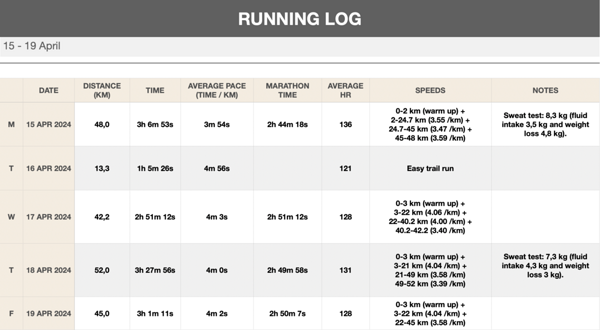After the Barcelona marathon, I took it very easy for a week and let my body recover. Then I started a training cycle, the culmination of which was the previous (i.e fifth week). I build the training cycles based on the goals of the last week, and that’s what generally determines the length of the cycle. Since my recovery rate and endurance are trained to such a high level, it takes quite a long time and effort to create the desired amount of stress on the body. Therefore, five, six, or seven-week long training cycles are common for me.
It’s important to always sense that delicate line that separates progress from overtraining and injuries. So far, I’ve managed to feel it more or less correctly, but just in case, I’ll spit over my left shoulder three times :). The fact that I haven’t been injured and therefore haven’t had to take a break from sports doesn’t mean that all my workouts go smoothly all the time. On the contrary, unexpected muscle issues and various concerns come up again and again. It cannot be otherwise, because then there is no reason to expect a big leap towards improvement.

Photo taken at the finish line of the Barcelona Marathon: https://marathonphotos.live/
Setbacks and unpleasant surprises are important in learning to know your body and its limits. Success doesn’t lie in hoping that problems won’t arise but in the ability to notice them in time, react correctly, and solve them on the go. In winter and early spring I use running to push my body and mind to the next level. For me, this often means many kilometers on consecutive days, and last week was no exception (see the table below).
When it comes to training, I mark down as many things as possible and later analyze them to find connections or patterns. Among other things, I’m particularly interested in everything related to recovery. That’s why I like to experiment a lot with different activities and evaluate how they affect my well-being and performance the next day. Even during the aforementioned week, I varied my activities from day to day. Sometimes I used cycling or swimming for recovery after a long run, other times both, sometimes I stretched, and sometimes I did nothing, etc. Cycling is definitely one of the activities that accelerates my recovery from a long run and has a significant positive effect on my well-being the next day.

I kind of like hot weather and the body can adapt to the heat very quickly. This has not always been the case. I believe that a large part of this is because I do a lot of indoor running on a treadmill. Writing down what I drink and eat during exercise and weighing myself before and after exercise helps me know how much fluid I’m consuming in different temperatures and conditions, and how much salt I need to eat to maintain that essential balance. Also, how much fluid I lose through sweating and how fluid intake changes as pace and heart rate change. Or, for example, how many carbohydrates the body can easily absorb during sports (without digestive problems) and whether and how far I can increase this ability.
You can see from the table above that in my case three hours of indoor running can mean up to 8 kg of fluid loss. For example, during a 52 km run, I had to change my t-shirts as many as ten times to prevent sweat from seeping into my pants and shoes. The comparison between Monday’s and Thursday’s long run shows how in my case even a slightly faster run and thus a slightly higher average heart rate has a significant effect on fluid loss and consumption.
It’s important to keep an eye on such data over a longer period of time. In this way, interesting patterns and other important observations will best stand out.
What next?
I plan to make my next start on Mother’s Day at the Tartu Forest Marathon, and then there are less than two weeks left until my first self-organized challenge. But more on that soon.